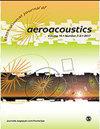亚音速射流噪声源位置与喷管出口边界层的关系
IF 1.3
4区 工程技术
Q3 ACOUSTICS
引用次数: 1
摘要
多年来,已经进行了大量关于确定亚音速喷气噪声源位置的研究,通常绘制为与喷嘴出口距离成函数的斯特劳哈尔数。对各种研究结果的比较得出了在测量源位置上大约两个喷嘴直径的分布。这项工作考察了不同喷嘴的边界层厚度如何可能是亚音速喷气噪声源位置不同研究中观察到的差异的原因。比较了具有相对较薄的喷嘴出口边界层的ASME喷嘴和具有相对较厚的喷嘴出口边缘层的锥形喷嘴的未加热射流的源位置测量。这些结果通过纹影流动可视化和速度剖面测量得到了证实。研究发现,喷嘴出口边界层较薄的喷嘴的噪声源分布比喷嘴出口边界线较厚的喷嘴的上游直径为0.25–2。更薄的喷嘴出口边界层导致不稳定波的增长率更高,增加了混合,从而将噪声源向上游移动。本文章由计算机程序翻译,如有差异,请以英文原文为准。
Subsonic jet noise source location as a function of nozzle exit boundary layer
Over the years, there have been numerous studies on determining subsonic jet noise source locations, typically plotted as Strouhal number as a function of distance from the nozzle exit. A comparison of the results of various studies yields a spread of about two nozzle diameters in measured source location. This work examines how boundary layer thickness, which can vary from nozzle to nozzle, could be the cause of observed differences in different studies in subsonic jet noise source location. Source location measurements of unheated jets from ASME nozzles, which have comparably thinner nozzle exit boundary layers, and conical nozzles, which have comparably thicker nozzle exit boundary layers, are compared. These results are substantiated with the use of schlieren flow visualization and velocity profile measurements. It is found that the nozzles with thinner nozzle exit boundary layers have noise source distributions that are 0.25–2 diameters upstream of those with thicker nozzle exit boundary layers. Thinner nozzle exit boundary layers result in higher growth rates of instability waves, increasing mixing and thereby moving noise sources upstream.
求助全文
通过发布文献求助,成功后即可免费获取论文全文。
去求助
来源期刊

International Journal of Aeroacoustics
ACOUSTICS-ENGINEERING, AEROSPACE
CiteScore
2.10
自引率
10.00%
发文量
38
审稿时长
>12 weeks
期刊介绍:
International Journal of Aeroacoustics is a peer-reviewed journal publishing developments in all areas of fundamental and applied aeroacoustics. Fundamental topics include advances in understanding aeroacoustics phenomena; applied topics include all aspects of civil and military aircraft, automobile and high speed train aeroacoustics, and the impact of acoustics on structures. As well as original contributions, state of the art reviews and surveys will be published.
Subtopics include, among others, jet mixing noise; screech tones; broadband shock associated noise and methods for suppression; the near-ground acoustic environment of Short Take-Off and Vertical Landing (STOVL) aircraft; weapons bay aeroacoustics, cavity acoustics, closed-loop feedback control of aeroacoustic phenomena; computational aeroacoustics including high fidelity numerical simulations, and analytical acoustics.
 求助内容:
求助内容: 应助结果提醒方式:
应助结果提醒方式:


